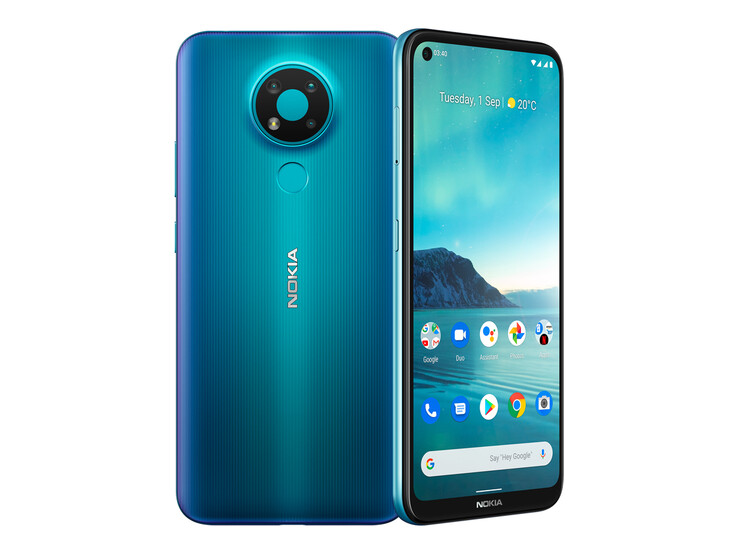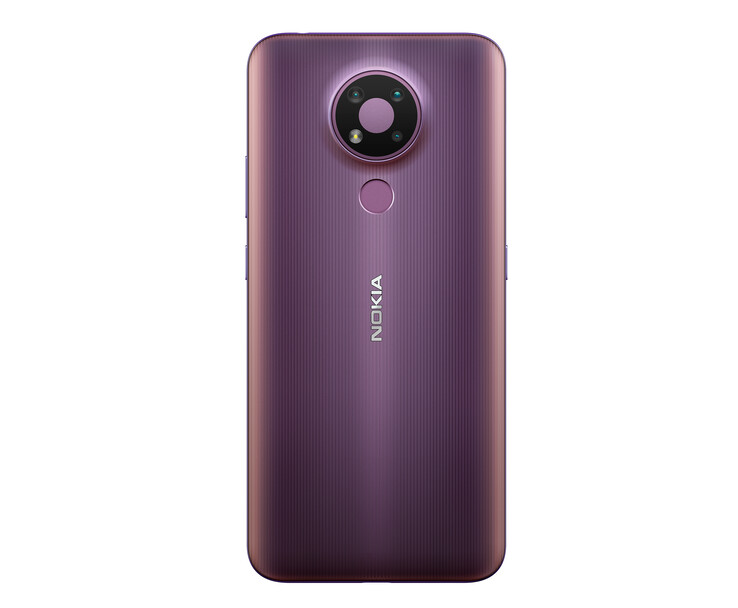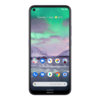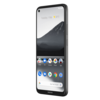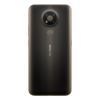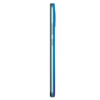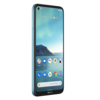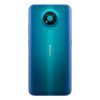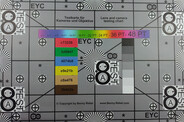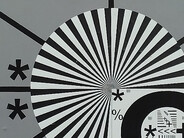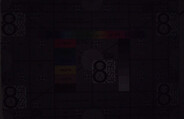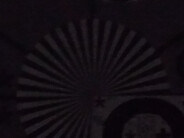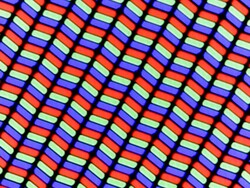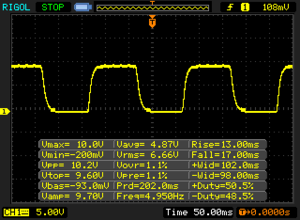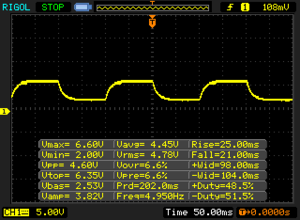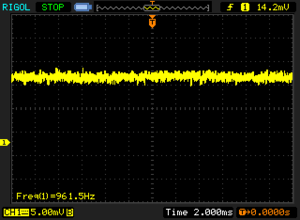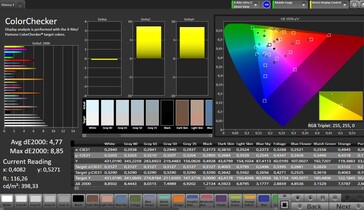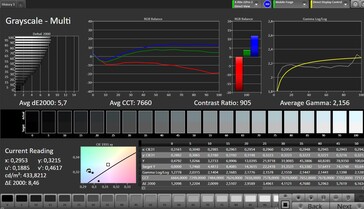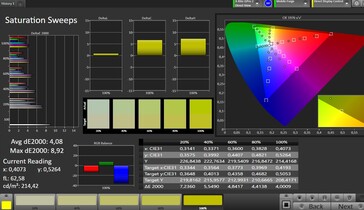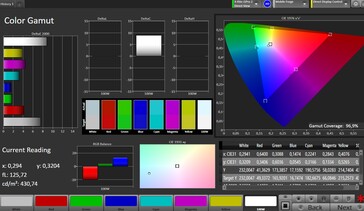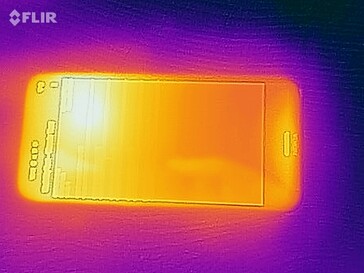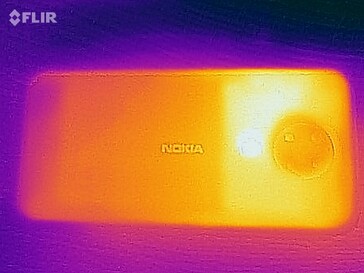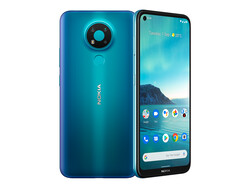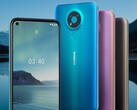Nokia 3.4 Smartphone Review - Lightweight, Colorful Nokia Phone
Possible competitors in comparison
Bewertung | Rating Version | Datum | Modell | Gewicht | Laufwerk | Groesse | Aufloesung | Preis ab |
|---|---|---|---|---|---|---|---|---|
| 76 % v7 (old) | v7 (old) | 12 / 2020 | Nokia 3.4 SD 460, Adreno 610 | 180 g | 64 GB eMMC Flash | 6.39" | 1560x720 | |
| 79.9 % v7 (old) | v7 (old) | 09 / 2020 | Xiaomi Redmi Note 9 Helio G85, Mali-G52 MP2 | 199 g | 64 GB eMMC Flash | 6.53" | 2340x1080 | |
| 77.9 % v7 (old) | v7 (old) | 10 / 2020 | Motorola Moto G9 Play SD 662, Adreno 610 | 200 g | 64 GB eMMC Flash | 6.50" | 1600x720 | |
| 75.4 % v7 (old) | v7 (old) | 11 / 2020 | Samsung Galaxy A20s SD 450, Adreno 506 | 183 g | 32 GB eMMC Flash | 6.50" | 1560x720 |
Case, features and operation - future-proof thanks to Android One
Nokia offers its affordable mid-range smartphone in three color variants, all three of which have a strong iridescence so that the color looks a bit different depending on the incidence of light. Anthracite (dark gray to brown), Dusk (rosé to violet) and Fjord (blue to green) are available. This color play is well done and gives the quite inexpensive smartphone a high-quality touch.
The back is only made of plastic, but that is not to be expected for considerably less than 200 Euros. The smartphone is well manufactured and quite stable. That's good news for those who don't want to carry a lot of weight around: The Nokia 3.4 is relatively light for its size at 180 grams.
The smartphone is available with 64 GB or 32 GB of mass storage, and you can also choose whether you only need one SIM slot or a dual-SIM slot, whereby the prices on the Internet are currently on a similar level here. The 32 GB variant is easiest to get directly from Nokia, but it is currently more expensive than other manufacturers' offers for the Nokia 3.4 with 64 GB of storage.
Although the SoC would theoretically support modern Wi-Fi 6, Nokia has only enabled Wi-Fi 4. In our test with the reference router Netgear Nighthawk AX12, the phone achieved an average data throughput of around 113-122 MBit/s, which is faster than Samsung's Galaxy A20s, for example. however, Redmi Note 9 and Moto G9 Play show that Wi-Fi 5 speed is also possible in this price category.
The LTE speed is also only LTE Cat.4. Older Bluetooth 4.2 is on board, but at least NFC for mobile payment services and other applications is also available.
Nokia's 3.4 is part of the Android-One program and is supposed to get regular security updates and two major operating system updates. Nokia promises the update to Android 11 for the first quarter of 2021. However, our device was not up to date with security patches from September 2020 at the time of testing.
A physical fingerprint sensor is found on the back, which unlocks the smartphone quite reliably after a short waiting period.
| Networking | |
| iperf3 transmit AX12 | |
| Xiaomi Redmi Note 9 | |
| Motorola Moto G9 Play | |
| Nokia 3.4 | |
| Samsung Galaxy A20s | |
| iperf3 receive AX12 | |
| Xiaomi Redmi Note 9 | |
| Motorola Moto G9 Play | |
| Nokia 3.4 | |
| Samsung Galaxy A20s | |
Cameras - Moderate sharpness
The main lens of the rear camera has a resolution of 13 megapixels. Pictures look very blurry and are only usable as snapshots. In low light, the illumination is mediocre and visible image distortions occur. This is not necessarily unusual at this price level, but there are also positive examples, such as Samsung's Galaxy A20s, which takes much sharper pictures.
The wide-angle camera also only produces rather poorly detailed pictures and distorts the colors of the sky.
Videos can be recorded in 1080p and with 30 fps at most. This is usual in the price range. The autofocus reacts quite slowly here, but the videos are otherwise of acceptable quality for the price range. You have to choose between a wide-angle or standard lens before recording.
An 8-megapixel camera is found at the front, and the selfie quality is quite respectable here.
Image comparison
Choose a scene and navigate within the first image. One click changes the position on touchscreens. One click on the zoomed-in image opens the original in a new window. The first image shows the scaled photograph of the test device.
Hauptobjektiv BlumeHauptobjektiv UmgebungHauptobjektiv Low LightUltraweitwinkel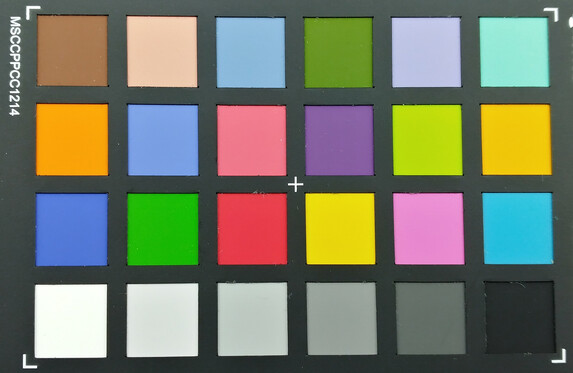
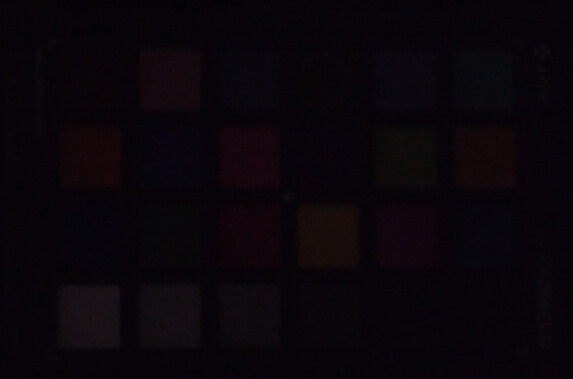
Display - class level, but no more
Nokia's 3.4 is equipped with a 720p screen, which is standard for its class. Xiaomi's Redmi Note 9 with its Full HD screen shows that it can be better. The screen's brightness is mediocre, the black value is also mediocre, and the contrast ratio of 1,100:1 is also mediocre.
The display should not be used to judge printing colors in view of the clear color deviations. There is a clear blue cast in grayscale.
We also noticed PWM flickering at very low display brightness, but at a fairly high frequency, so most people should not have any problems here.
| |||||||||||||||||||||||||
Brightness Distribution: 91 %
Center on Battery: 440 cd/m²
Contrast: 1100:1 (Black: 0.4 cd/m²)
ΔE ColorChecker Calman: 4.77 | ∀{0.5-29.43 Ø4.77}
ΔE Greyscale Calman: 5.7 | ∀{0.09-98 Ø5}
96.9% sRGB (Calman 2D)
Gamma: 2.156
CCT: 7660 K
| Nokia 3.4 IPS, 1560x720, 6.4" | Xiaomi Redmi Note 9 IPS LCD, 2340x1080, 6.5" | Motorola Moto G9 Play IPS, 1600x720, 6.5" | Samsung Galaxy A20s IPS, 1560x720, 6.5" | |
|---|---|---|---|---|
| Response Times | 16% | -13% | 6% | |
| Response Time Grey 50% / Grey 80% * (ms) | 46 ? | 38.8 ? 16% | 52 ? -13% | 44 ? 4% |
| Response Time Black / White * (ms) | 30 ? | 25.6 ? 15% | 34 ? -13% | 28 ? 7% |
| PWM Frequency (Hz) | 962 ? | |||
| Screen | 65% | 8% | -2% | |
| Brightness middle (cd/m²) | 440 | 553 26% | 450 2% | 384 -13% |
| Brightness (cd/m²) | 417 | 527 26% | 428 3% | 367 -12% |
| Brightness Distribution (%) | 91 | 89 -2% | 88 -3% | 87 -4% |
| Black Level * (cd/m²) | 0.4 | 0.12 70% | 0.23 42% | 0.42 -5% |
| Contrast (:1) | 1100 | 4608 319% | 1957 78% | 914 -17% |
| Colorchecker dE 2000 * | 4.77 | 3.8 20% | 5.49 -15% | 4.43 7% |
| Colorchecker dE 2000 max. * | 8.85 | 8.7 2% | 10.19 -15% | 7.34 17% |
| Greyscale dE 2000 * | 5.7 | 2.2 61% | 7.5 -32% | 4.9 14% |
| Gamma | 2.156 102% | 2.3 96% | 2.495 88% | 2.308 95% |
| CCT | 7660 85% | 6727 97% | 8711 75% | 7671 85% |
| Total Average (Program / Settings) | 41% /
55% | -3% /
3% | 2% /
-0% |
* ... smaller is better
Display Response Times
| ↔ Response Time Black to White | ||
|---|---|---|
| 30 ms ... rise ↗ and fall ↘ combined | ↗ 13 ms rise | |
| ↘ 17 ms fall | ||
| The screen shows slow response rates in our tests and will be unsatisfactory for gamers. In comparison, all tested devices range from 0.1 (minimum) to 240 (maximum) ms. » 79 % of all devices are better. This means that the measured response time is worse than the average of all tested devices (20.2 ms). | ||
| ↔ Response Time 50% Grey to 80% Grey | ||
| 46 ms ... rise ↗ and fall ↘ combined | ↗ 25 ms rise | |
| ↘ 21 ms fall | ||
| The screen shows slow response rates in our tests and will be unsatisfactory for gamers. In comparison, all tested devices range from 0.165 (minimum) to 636 (maximum) ms. » 78 % of all devices are better. This means that the measured response time is worse than the average of all tested devices (31.6 ms). | ||
Screen Flickering / PWM (Pulse-Width Modulation)
| Screen flickering / PWM detected | 962 Hz | ≤ 20 % brightness setting | |
The display backlight flickers at 962 Hz (worst case, e.g., utilizing PWM) Flickering detected at a brightness setting of 20 % and below. There should be no flickering or PWM above this brightness setting. The frequency of 962 Hz is quite high, so most users sensitive to PWM should not notice any flickering. In comparison: 53 % of all tested devices do not use PWM to dim the display. If PWM was detected, an average of 8084 (minimum: 5 - maximum: 343500) Hz was measured. | |||
Performance, emissions and battery life - Good endurance
The still quite new Snapdragon 460 is used in Nokia's 3.4. Compared with the Snapdragon 450 in Samsung's Galaxy A20s, it shows a significant performance increase and can also keep up with the other comparison devices to some extent. Thus, you get a good performance package for the price, also in terms of graphics performance. The smartphone usually runs smoothly in everyday use, but it only starts to sweat during more complex apps.
The storage is on par with the class in terms of speed. Our reference microSD, a Toshiba Exceria Pro M501, is also read quickly.
Nokia's 3.4 heats up considerably in some places. This warming is not critical in normal temperatures, but it can be unpleasant on hot days when the smartphone is loaded.
The speaker cannot get particularly loud, but it does not sound too bad for such a cheap smartphone. Sure, low mids are hardly audible, but at least the trebles do not clang unpleasantly and you can definitely listen to a video or music track. Audiophiles will rather use headphones or external speakers, which can be connected via a 3.5 mm port or Bluetooth including the sound enhancement aptX.
Nokia's 3.4 has a 4,000 mAh battery, which puts it in the midfield in terms of capacity. The runtimes in our Wi-Fi test are nevertheless almost on par with the Redmi Note 9 with a much bigger battery; the modern SoC and the low screen resolution probably pay off here. Thanks to a runtime of 14 hours, it should be enough for two days without charging. Charging only works with a maximum of 10 watts and takes a good 2 hours.
| PCMark for Android | |
| Work performance score (sort by value) | |
| Nokia 3.4 | |
| Xiaomi Redmi Note 9 | |
| Motorola Moto G9 Play | |
| Samsung Galaxy A20s | |
| Average Qualcomm Snapdragon 460 (7036 - 7779, n=5) | |
| Work 2.0 performance score (sort by value) | |
| Nokia 3.4 | |
| Xiaomi Redmi Note 9 | |
| Motorola Moto G9 Play | |
| Samsung Galaxy A20s | |
| Average Qualcomm Snapdragon 460 (5316 - 5869, n=5) | |
| GFXBench | |
| on screen Aztec Ruins Normal Tier Onscreen (sort by value) | |
| Nokia 3.4 | |
| Motorola Moto G9 Play | |
| Samsung Galaxy A20s | |
| Average Qualcomm Snapdragon 460 (11 - 11, n=5) | |
| Average of class Smartphone (6.2 - 166, n=208, last 2 years) | |
| 1920x1080 Aztec Ruins Normal Tier Offscreen (sort by value) | |
| Nokia 3.4 | |
| Motorola Moto G9 Play | |
| Samsung Galaxy A20s | |
| Average Qualcomm Snapdragon 460 (6 - 6.1, n=5) | |
| Average of class Smartphone (3.4 - 367, n=208, last 2 years) | |
| on screen Aztec Ruins High Tier Onscreen (sort by value) | |
| Nokia 3.4 | |
| Motorola Moto G9 Play | |
| Samsung Galaxy A20s | |
| Average Qualcomm Snapdragon 460 (6.5 - 6.8, n=5) | |
| Average of class Smartphone (0.85 - 144, n=209, last 2 years) | |
| 2560x1440 Aztec Ruins High Tier Offscreen (sort by value) | |
| Nokia 3.4 | |
| Motorola Moto G9 Play | |
| Samsung Galaxy A20s | |
| Average Qualcomm Snapdragon 460 (2 - 2, n=5) | |
| Average of class Smartphone (1.2 - 146, n=208, last 2 years) | |
| Nokia 3.4 | Xiaomi Redmi Note 9 | Motorola Moto G9 Play | Samsung Galaxy A20s | Average 64 GB eMMC Flash | Average of class Smartphone | |
|---|---|---|---|---|---|---|
| AndroBench 3-5 | 36% | 17% | -28% | -19% | 558% | |
| Sequential Read 256KB (MB/s) | 301.9 | 306.6 2% | 315.2 4% | 298.2 -1% | 277 ? -8% | 2235 ? 640% |
| Sequential Write 256KB (MB/s) | 221.6 | 248.1 12% | 187.2 -16% | 90.6 -59% | 178.4 ? -19% | 1871 ? 744% |
| Random Read 4KB (MB/s) | 123.1 | 65.1 -47% | 98.4 -20% | 75.9 -38% | 60.7 ? -51% | 297 ? 141% |
| Random Write 4KB (MB/s) | 42.5 | 146.9 246% | 96.1 126% | 12.95 -70% | 33.8 ? -20% | 343 ? 707% |
| Sequential Read 256KB SDCard (MB/s) | 85.8 ? | 84.4 ? -2% | 85.4 ? 0% | 82.6 ? -4% | 77.4 ? -10% | |
| Sequential Write 256KB SDCard (MB/s) | 62.4 ? | 63.5 ? 2% | 65.3 ? 5% | 65.1 ? 4% | 58.3 ? -7% |
Temperature
(±) The maximum temperature on the upper side is 43.2 °C / 110 F, compared to the average of 35.2 °C / 95 F, ranging from 21.9 to 247 °C for the class Smartphone.
(±) The bottom heats up to a maximum of 41.6 °C / 107 F, compared to the average of 34 °C / 93 F
(+) In idle usage, the average temperature for the upper side is 26.4 °C / 80 F, compared to the device average of 32.9 °C / 91 F.
Loudspeaker
Nokia 3.4 audio analysis
(±) | speaker loudness is average but good (76.3 dB)
Bass 100 - 315 Hz
(-) | nearly no bass - on average 32.4% lower than median
(±) | linearity of bass is average (13.2% delta to prev. frequency)
Mids 400 - 2000 Hz
(+) | balanced mids - only 4.8% away from median
(+) | mids are linear (6% delta to prev. frequency)
Highs 2 - 16 kHz
(+) | balanced highs - only 2.2% away from median
(+) | highs are linear (4.8% delta to prev. frequency)
Overall 100 - 16.000 Hz
(±) | linearity of overall sound is average (26.4% difference to median)
Compared to same class
» 67% of all tested devices in this class were better, 5% similar, 27% worse
» The best had a delta of 11%, average was 35%, worst was 134%
Compared to all devices tested
» 81% of all tested devices were better, 4% similar, 15% worse
» The best had a delta of 4%, average was 24%, worst was 134%
Samsung Galaxy A20s audio analysis
(±) | speaker loudness is average but good (81.5 dB)
Bass 100 - 315 Hz
(-) | nearly no bass - on average 64% lower than median
(+) | bass is linear (0% delta to prev. frequency)
Mids 400 - 2000 Hz
(-) | nearly no mids - on average 64% lower than median
(+) | mids are linear (0% delta to prev. frequency)
Highs 2 - 16 kHz
(-) | nearly no highs - on average 64% lower than median
(+) | highs are linear (0% delta to prev. frequency)
Overall 100 - 16.000 Hz
(-) | overall sound is not linear (119.8% difference to median)
Compared to same class
» 88% of all tested devices in this class were better, 9% similar, 3% worse
» The best had a delta of 11%, average was 35%, worst was 134%
Compared to all devices tested
» 97% of all tested devices were better, 3% similar, 1% worse
» The best had a delta of 4%, average was 24%, worst was 134%
Battery life
| Nokia 3.4 4000 mAh | Xiaomi Redmi Note 9 5020 mAh | Motorola Moto G9 Play 5000 mAh | Samsung Galaxy A20s 4000 mAh | Average of class Smartphone | |
|---|---|---|---|---|---|
| Battery Runtime | |||||
| WiFi Websurfing (h) | 14.1 | 14.5 3% | 16 13% | 13.5 -4% | 19.3 ? 37% |
Pros
Cons
Verdict - Nokia 3.4 with only one weakness
Nokia's 3.4 looks chic, is not too heavy for its size, and comes with a certain future-proofing with Android One, which is otherwise often searched for in vain in inexpensive smartphones. The battery runtimes are good, the device offers a decent performance level and the speakers are not bad at all.
However, Nokia only delivers standard fare for the price range in many areas. Xiaomi's Redmi Note 9 in particular is ahead in many areas, for example in screen resolution or WLAN speed.
The Nokia 3.4 is a good and inexpensive smartphone whose most obvious weakness is the camera.
We could hardly determine any serious weaknesses in our test, apart from the camera, which is only really suitable for snapshots at most. If that does not bother you, you will get a solid device from the lower mid-range.
Price and availability
The Nokia 3.4 with 64 GB of mass storage is available from 145 Euros at the time of testing. Among others, at Amazon, Cyberport or notebooksbilliger.de.
Nokia 3.4
- 12/22/2020 v7 (old)
Florian Schmitt




